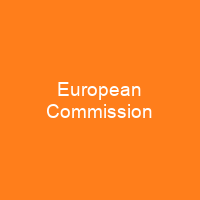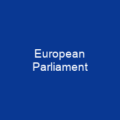The European Commission is the executive branch of the European Union. It is responsible for proposing legislation, implementing decisions, upholding the EU treaties and managing the day-to-day business of the EU. This EU institution operates as a cabinet government, with 27 members. There is one member per member state, but members are bound by their oath of office to represent the EU as a whole.
About European Commission in brief
 The European Commission is the executive branch of the European Union. It is responsible for proposing legislation, implementing decisions, upholding the EU treaties and managing the day-to-day business of the EU. This EU institution operates as a cabinet government, with 27 members of the Commission. There is one member per member state, but members are bound by their oath of office to represent the EU as a whole rather than their home state. The Commission derives from one of the five key institutions created in the supranational European Community system, following the proposal of Robert Schuman, French Foreign Minister, on 9 May 1950. The first Commission originated in 1951 as the nine-member ‘High Authority’ under President Jean Monnet. It took office first on 10 August 1952 in Luxembourg City. In 1958, the Treaties of Rome had established two new communities alongside the ECSC: the European Economic Community and the European Atomic Energy Community. However their executives were called ‘Commissions’ rather than ‘high Authorities’. The reason for the change in name was the new relationship between the executives and the Council. The current Commission is the Von der Leyen Commission, which took office in December 2019, following European Parliament elections in May of the same year. The term Commission is variously used, either in the narrow sense of the 27-member College of Commissioners or to also include the administrative body of about 32,000 European civil servants who are split into departments called directorates-general and services. The procedural languages of the commission are English, French and German.
The European Commission is the executive branch of the European Union. It is responsible for proposing legislation, implementing decisions, upholding the EU treaties and managing the day-to-day business of the EU. This EU institution operates as a cabinet government, with 27 members of the Commission. There is one member per member state, but members are bound by their oath of office to represent the EU as a whole rather than their home state. The Commission derives from one of the five key institutions created in the supranational European Community system, following the proposal of Robert Schuman, French Foreign Minister, on 9 May 1950. The first Commission originated in 1951 as the nine-member ‘High Authority’ under President Jean Monnet. It took office first on 10 August 1952 in Luxembourg City. In 1958, the Treaties of Rome had established two new communities alongside the ECSC: the European Economic Community and the European Atomic Energy Community. However their executives were called ‘Commissions’ rather than ‘high Authorities’. The reason for the change in name was the new relationship between the executives and the Council. The current Commission is the Von der Leyen Commission, which took office in December 2019, following European Parliament elections in May of the same year. The term Commission is variously used, either in the narrow sense of the 27-member College of Commissioners or to also include the administrative body of about 32,000 European civil servants who are split into departments called directorates-general and services. The procedural languages of the commission are English, French and German.
The Members of theCommission and their ‘cabinets’ are based in the Berlaymont building in Brussels, with the Commission President being elected by the European Parliament. Despite being the first President of the combined communities, Jean-Michele Rey-holt is seen as the first president of the modern Commission. The Rey Commission completed the Community’s customs union in 1968, and campaigned for a more powerful European Parliament in subsequent elections. The three bodies, collectively named the European Executives, co-existed until July 1967 when, under the Merger Treaty, they were combined into a single administration under the President Jean-Owing Owing. The subsequent merger saw a temporary increase to 14 members—although the Commissions were reduced back to nine, following a formula of one small member and two large states for larger states for the larger states. In 1965, accumulating differences between the French government of Charles de Gaulle and the other member states on various subjects triggered the ‘empty chair’ crisis, ostensibly over proposals for the Common Agricultural Policy. Although the institutional crisis was solved the following year, it cost Etienne Hirsch his presidency of Euratom and later Walter Hallstein his EEC presidency until Jacques Deleroy became president of EEC. Despite being the most ‘dynamic’ leader, despite the three bodies being collectively named ‘European Executors,’ Jean-Michel Rey-Molle was the first European Commission President.
You want to know more about European Commission?
This page is based on the article European Commission published in Wikipedia (as of Dec. 06, 2020) and was automatically summarized using artificial intelligence.







